Research Paper - (2013) Volume 21, Issue 4
CLAHRC-LNR, Implementation Theme Manager
Richard Baker MD FRCGP
Professor of Quality in Health Care, Director of CLAHRC-LNR
Lorraine Pollard BSc MSc
CLAHRC-LNR, Implementation Researcher
Department of Health Sciences, University of Leicester, UK
Mei Yee Tang BSc MSc
CLAHRC-LNR, Implementation Intern, School of Psychological Sciences, University of Manchester, UK
Received date: 15 March 2013; Accepted date: 19 June 2013
BackgroundA tailored approach to implementation can facilitate the routine use of best evidence, and so improve the quality of care delivered. Tailored implementation involves investigating the context and barriers to change before selecting appropriate interventions. However, there is little evidence on the methods of tailoring. This study investigated the tailoring undertaken by two implementation groups as part of a study to improve adherence to NICE guidelines on adult obesity in primary care. MethodsData were collected from interviews with healthcare professionals and patients on barriers and enablers to implementing NICE guidelines on adult obesity along with practice performance data on body mass index (BMI) recording and use of interventions for obesity. Findings were presented to medical practitioners, university and NHS staff (n = 12) who formed two implementation groups to independently identify the most important barriers and enablers, and to suggest interventions to facilitate the implementation of the NICE guidelines. Each group had a facilitator and were observed by researchers whose notes were used to understand the group processes and assess the usefulness of this method. ResultsWithin the time available both implementation groups reached consensus on the most important barriers and enablers and, led by those who had personal experience of managing patients with weight problems, made practical proposals for interventions to improve the implementation of the NICE guidelines. The role of the facilitator was crucial in ensuring barriers, enablers and nterventions were all discussed and agreed upon in the time available. ConclusionsThe facilitated implementation groups method succeeded in identifying appropriate and similar barriers, enablers and implementation interventions, which suggests some justification for this approach to tailoring. However, further research into methods of tailoring is required. Improvements to the implementation group approach may be realised by careful selection of group members and provision of sufficient preparation time prior to group discussions.
barriers, general practice, groups, im-plementation, intervention, primary care, tailor
Introduction
It is well established that health systems ‘fail to optimally use evidence’, often with a long delay before research has an impact on clinical practice.[1–3] In England, summaries of evidence and evidence-based clinical guidelines are produced as well as guidance on implementation[4] to help address this problem and so improve the quality of care. However, an implemen-tation uptake report on the surgical and pharmaco-logical interventions for obesity found the National Institute for Health and Clinical Excellence (NICE) clinical guidelines had mixed impact in practice.[5] Prescription patterns were in line with the NICE guidance, but a low proportion of patients received lifestyle advice prior to the start of their drug treat-ment. Lack of adherence to the NICE clinical guide-lines for obesity was also reported by the Office of Health Economics (OHE),[6] which administered ques-tionnaires to primary care trusts (PCTs) to assess their views on the degree of similarity between their local referral process for obesity and the NICE guidance. (Throughout the paper we refer to the NICE clinical guidelines developed for adults because issues for children may be different.)
With around a quarter of the English population having obesity,[7] the effective implementation of NICE clinical guidance on obesity in primary care has the potential to benefit health and reduce the economic burden of the health consequences of obesity.[8] How-ever, a number of barriers have been identified that hinder the implementation of evidence-based clinical guidelines, grouped according to their exect on clinical knowledge, attitudes and behaviour.[9] Because several barriers may be present, a single implementation inter-vention is unlikely to be adequate: a combined strategy taking account of the particular problem, the specific context, the needs of the target groups, and tailored to the identified barriers is likely to be more exective.[10]
A systematic review of randomised controlled trials found that tailored interventions were more exective than no intervention or to dissemination of guidelines and educational materials alone.[11] Tailoring involvestwo key steps. The first involves investigation of context and the prevailing barriers to change in which a variety of methods may be used with professionals and patients including: interviews, focus groups, questionnaires and observation. The second step in-volves the selection of intervention methods chosen to account for the barriers that have been identified.
However, it is unclear which approaches should be used to select interventions likely to be effective in the presence of specific barriers. Although many studies have been undertaken of barriers to implementation in different settings,[9] there is little evidence on means of selecting interventions once the barriers have been identified. Typically, the selection of interventions as reported in trials is undertaken by research or im-plementation teams, drawing on the evidence they have collected and their own experience of both clin-ical practice and of implementation.[12]
It is conceivable that different teams or groups using this pragmatic approach would select different interventions when presented with the same barriers, depending on their perspectives and experience. Therefore, to begin to investigate methods of selecting interventions for tailored implementation, we under-took a study to compare tailoring undertaken by two implementation groups, as part of a project under-taken by the Collaboration for Leadership in Applied Health Research and Care (CLAHRC) in Leicestershire, Northamptonshire and Rutland (LNR) to improve adherence to NICE guidelines on obesity in primary care.[13]
Setting
The study took place in the East Midlands region of England. A small sample of rural and urban general practices was selected through consultation with three local PCTs, the bodies responsible for administering primary care services, as being interested in obesity management and with different levels of performance in the obesity domain of the national pay for per-formance scheme referred to as the Quality and Outcomes Framework (QOF).[14]
Identification of barriers and interventions
Two data sources were employed at the participating general practices.
Data collection from records
MIQUEST is a methodology and an approach to common data access which enables enquirers to ex-ecute queries and extract data from different types of general medical practice computer systems using a common query language. A MIQUEST query search developed specifically for this study was used, data were collected twice, at baseline and again six months after the tailored intervention package was delivered. The following data were extracted:[15]
• proportion of adults in diferent age groups who had a BMI recorded in the past 3 years
• record of any discussion of weight in the past 15 months with patients in either the overweight or obese categories
• proportion of adults whose BMI recorded in the past 15 months was in either the overweight or obese categories
• record of more systematic intervention, including diet and exercise advice, referral to practice nurse clinic or a community weight reduction scheme
• proportion of patients who were registered as obese (BMI > 30) or overweight (BMI > 27) with a comorbidity who were on drug treatment.
The time periods were those required by the QOF.
Semi-structured interviews with healthcare professionals and patients
Semi-structured interviews were conducted with health-care professionals and patients to explore barriers and enablers to implementing NICE guidelines on obesity.[16]
Implementation groups
Medical practitioners, PCT managers and researchers with an interest in, and knowledge of, implementation and/or the management of obesity were sought to form two small groups that would be suitable to undertake the analysis of the barriers and enablers. The findings from the interviews with general prac-titioners (GPs), practice nurses and patients were presented together with an opportunity to ask ques-tions to ensure that everyone received the same information. The members of the project steering group were then randomly allocated to one of two groups to allow problems and possible solutions to be debated from different perspectives. These ‘imple-mentation groups’ were then asked to consider the findings presented and to identify the three most important barriers and the three most important enablers to the implementation of the NICE guide-lines on obesity, and to make practical proposals for interventions for each of these barriers and enablers. Each group was blind to the discussion in the other group and met once only. In the absence of explicit details for small group processes and in keeping with the pragmatic approach adopted, we sought informal consensus of opinion within each group with the help of the group facilitator whose role was to emphasise the need to reach consensus, and summarise agree-ments reached, but not to actively lead the group towards consensus.[17]
The groups were facilitated by a researcher and observed by a second researcher in order to generate understanding of the processes followed. A non-participative structured observational approach was adopted, with the observers making notes during the groups’ discussions on an observer’s sheet (Box 1).[16]
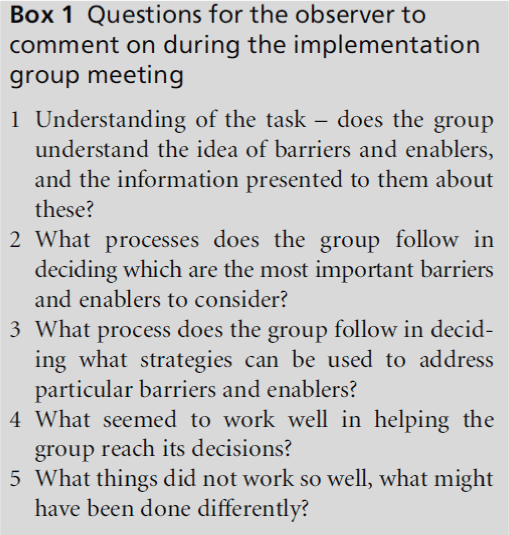
The questions were the result of discussions by the research team to guide the observers to focus on the key issues that would illuminate the implementation group processes and produce manageable data sets. Each group facilitator recorded the agreed key barriers and enablers and the proposed interventions during the meetings. Once the discussions had been com-pleted, we compared and contrasted the descriptions of barriers and enablers produced by the two groups and their proposed interventions for implementation. We then prepared an intervention package for prac-tices participating in the study. The recorded obser-vations from both groups were then examined to help
understand the processes used by the two groups in identifying the most important barriers and enablers, and interventions selected in response to them. When necessary, clarification of aspects of the notes and confirmation of the interpretation was sought later, directly from the observers, to ensure accuracy.
Approval for this study was granted by University of Leicester Ethics Committee and the PCTs in Leicester, Leicestershire and Northamptonshire. All participants gave their consent.
Record review
The practices had not identified as many people with obesity as predicted from population surveys (Table 1) and interventions to assist weight loss were not delivered consistently (Table 2).[18]
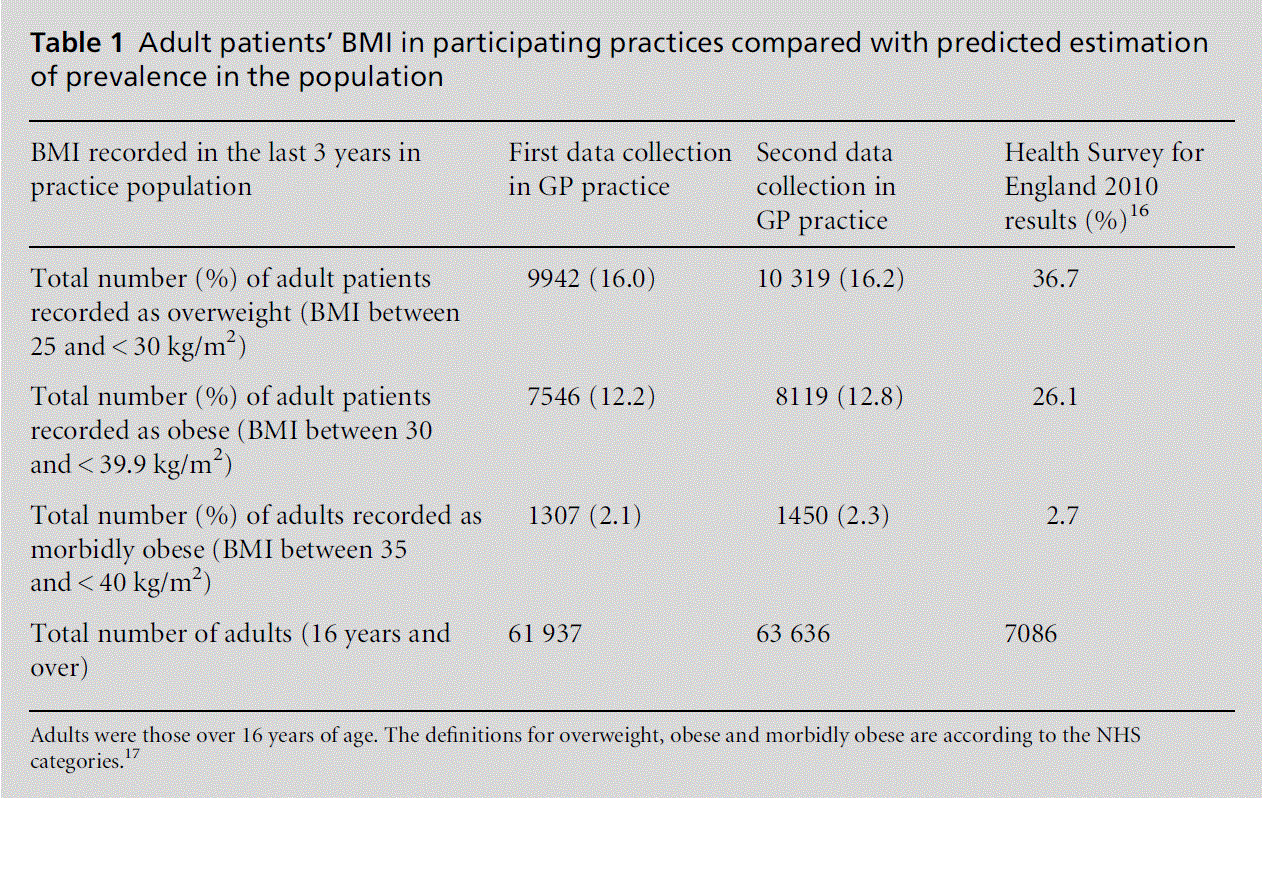
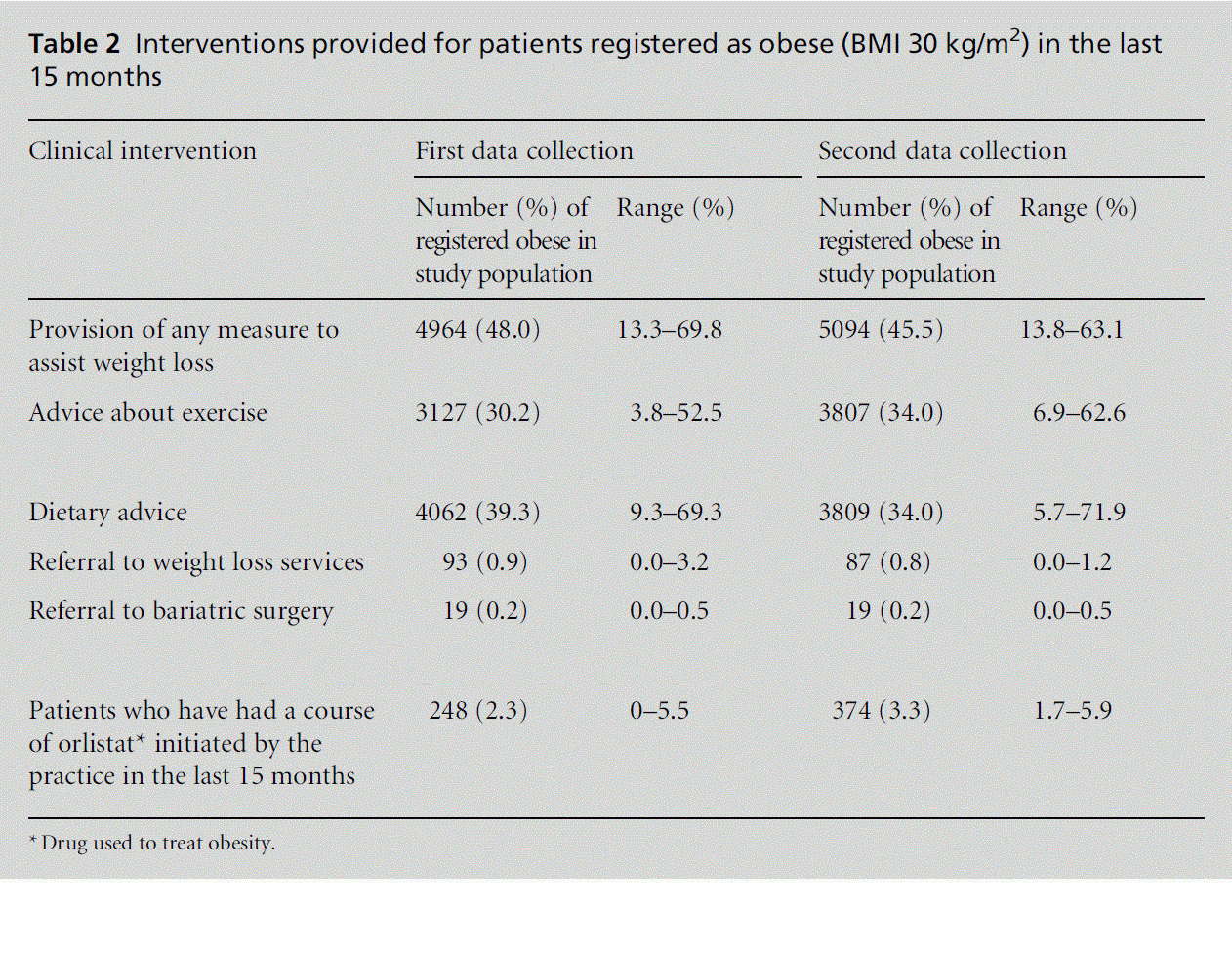
Findings of the semi-structured interviews
The interviewees were seven GPs, seven practice nurses and nine overweight or obese patients. (Further details of the findings from the semi-structured inter-views are presented in a companion paper.)[19] The data were analysed using a thematic framework and the findings of the interviews are summarised in Table 3.[20]
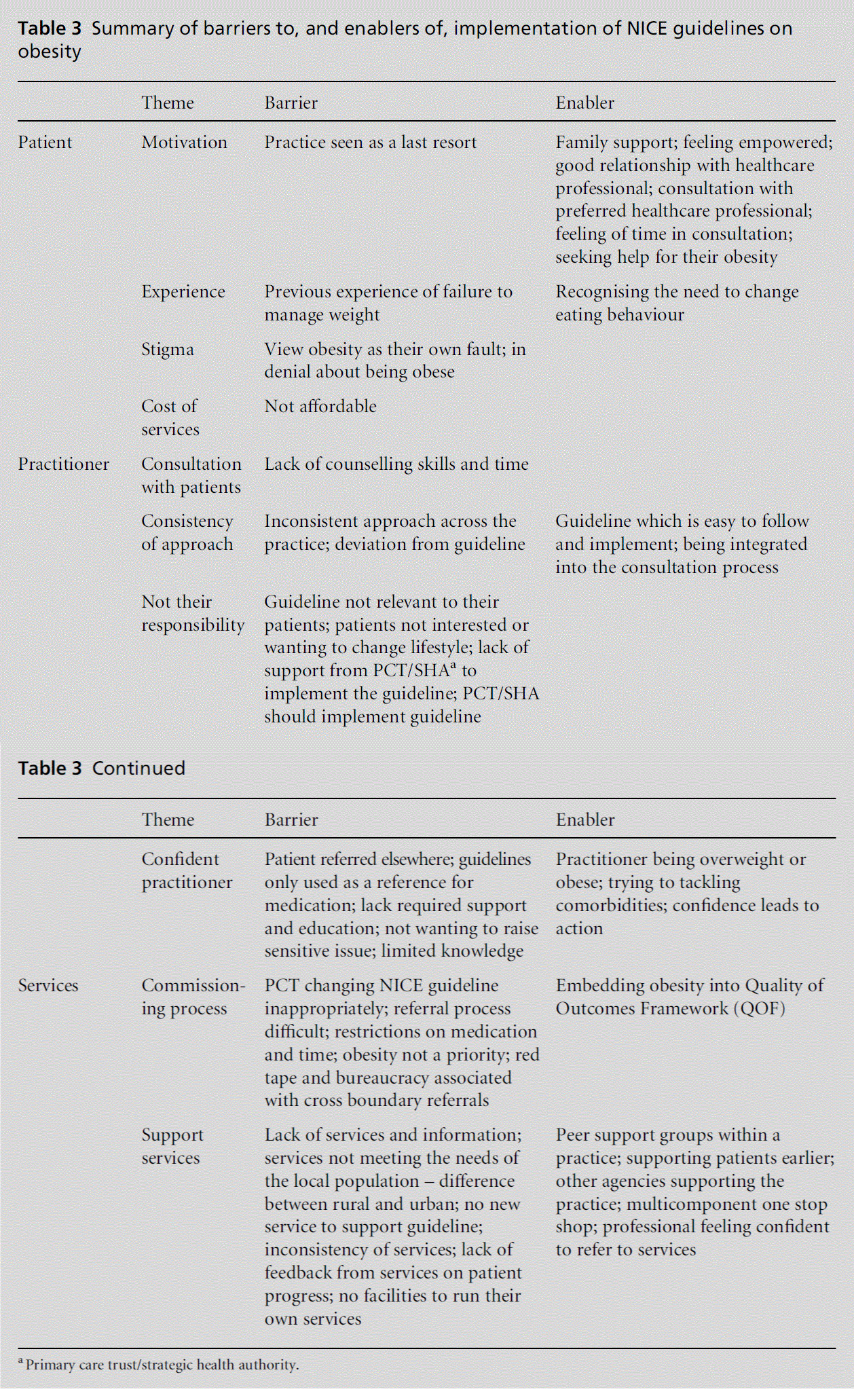
Implementation groups
Implementation group A (n = 6) consisted of three medical practitioners, two PCT managers and a mem-ber of the research and development (R&D) support staff from a mental health trust. Implementation group B (n = 6) consisted of three PCT stat, two university academic stat and a member of the R&D support staff from a mental health trust. Each group met for 60 minutes. The members of each group discussed the interview data, drawing on their experi-ence and knowledge to explore the barriers and enablers to implementing the NICE guidelines on obesity. To focus the discussion both groups were encouraged to identify up to three key barriers and three key enablers and to suggest ways in which these may be addressed to improve the implementation of the NICE guidelines. Both groups identified three key barriers and made practical proposals for inter-ventions to overcome the barriers (Table 4). Group A identified three key enablers and Group B identified two. Both groups made practical proposals for making use of the enablers to facilitate the implementation of the guidelines (Table 5).
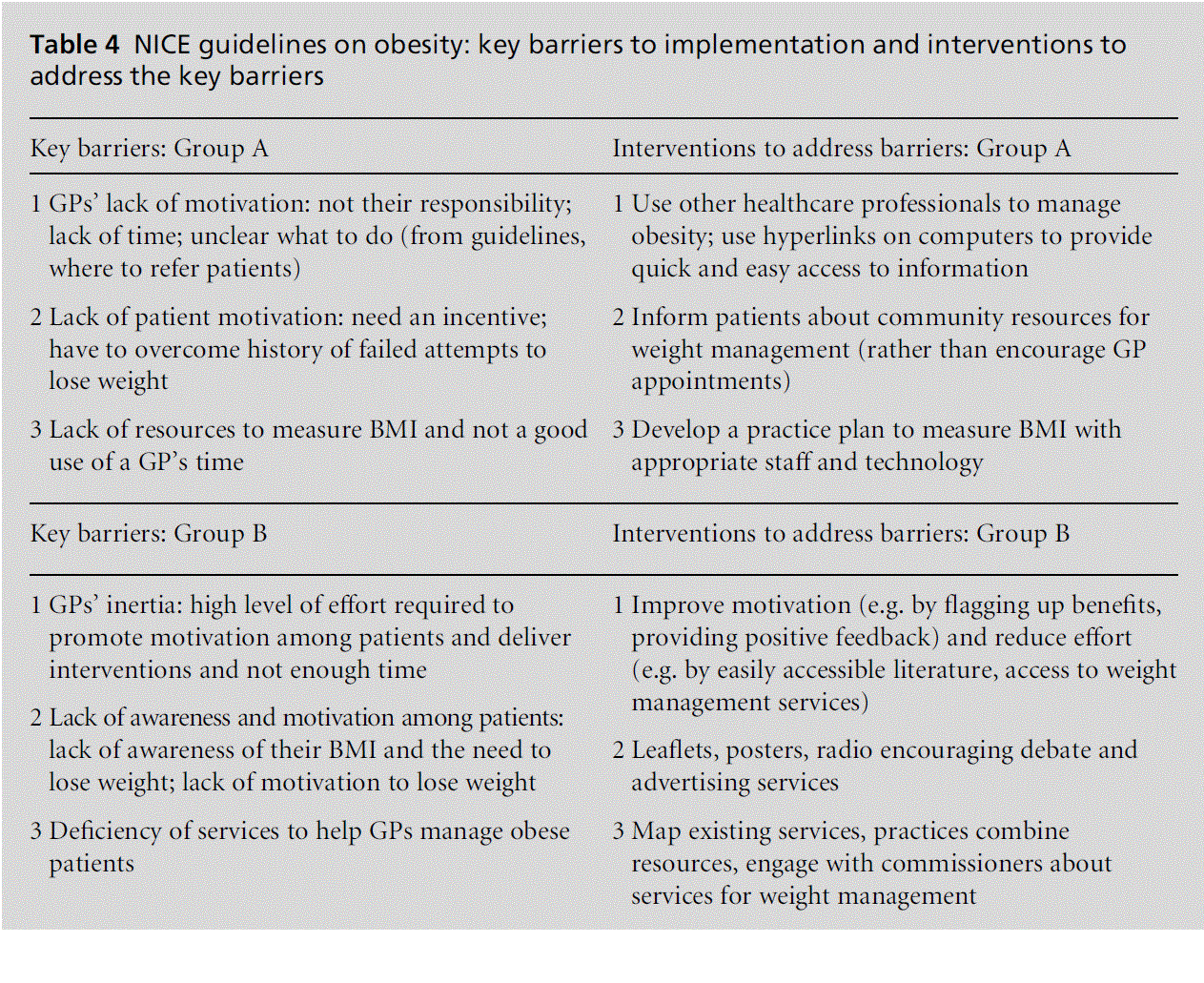
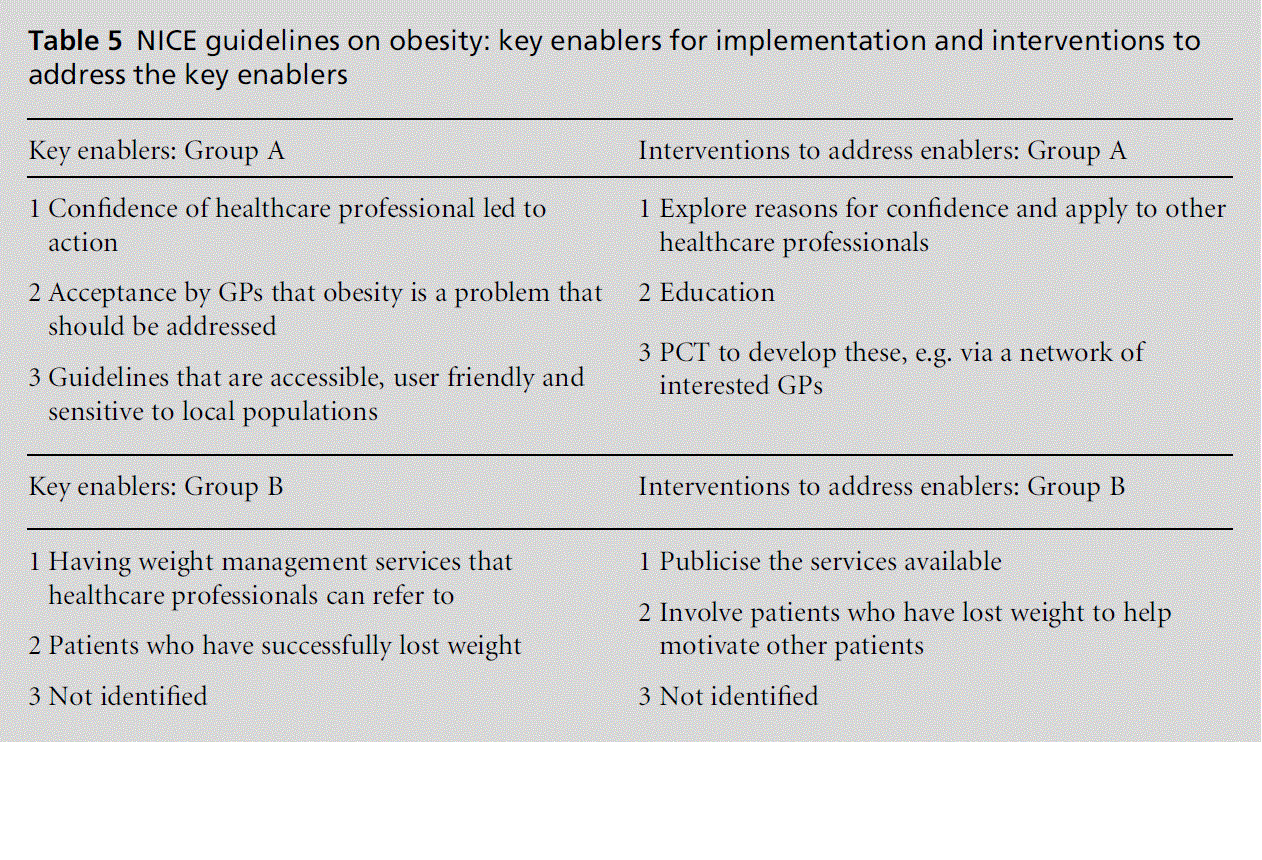
The tailoring process
Understanding of the task: does the group understand the idea of barriers and enablers, and the information presented to them about these?
Each observer considered whether members of the group understood the information that had been presented to them about the findings from the inter-views and, following a summary of the task from the facilitator, were clear about the task they had been given. Both groups appeared to find the concept of barriers and enablers easy to understand and started to discuss them without further explanation or prompt-ing by the facilitators.
What processes does the group follow in deciding the most important barriers and enablers to consider?
Both groups were observed to readily discuss the barriers to the implementation of the NICE guide-lines. In Group A there was a tendency for several members to contribute extensively to the discussions due to their personal experience of managing patients with weight problems. The facilitator had to press the group to decide on the three most important barriers. In Group B, consensus was reached quite quickly as two group members put their views forward and sought and secured the agreement of the others. Neither group moved on to discussing the enablers of their own accord. These were addressed eventually following prompting by the facilitators, but received less atten-tion during the limited time available.
What process does the group follow in deciding on the strategies to use to address particular barriers and enablers?
Once the key barriers and enablers had been agreed, the facilitator asked for suggestions on how they could be addressed. The discussions in both groups were largely informed by those participants who were able to draw on their own personal experiences in managing patients with weight problems. Having given everyone the opportunity to express their views, the facilitator summarised the suggested strategies and the group reached a consensus, led by the most vocal members.
What seemed to work well in helping the group reach its decisions?
The facilitator’s role was crucial in ensuring that: all group members had the opportunity to participate, the group focused on identifying the three most import-ant barriers and enablers, there was discussion and agreement on practical proposals for interventions, and the time limits were observed. The varied back-grounds of the group members enabled the issues to be discussed from a range of perspectives and avoided group polarisation, where decisions are reached which are more extreme than those that individuals would make.[21] Having a strict time limit was important to ensure that the discussions did not continue without a clear purpose or resolution.
What things did not work so well, what might have been done diferently?
There were two aspects of the implementation groups that could usefully be addressed: more equal time given to all aspects of the task and ensuring more equal contributions from members of the groups. Inviting the participants to initially write down their suggestions for the three most important barriers and enablers and the interventions before sharing with the group might ensure that all members of the group had time to reflect on the information and to formulate their own ideas prior to the discussion. Another part of the nominal group technique that could also usefully be adopted is to initially record all these ideas before discussion takes place to avoid initial criticism.[22] This step would encourage more equal participation in the discussion and may also help to ensure that all aspects of the task received more equal consideration. In add-ition, the selection of group members would benefit from greater attention as there was a tendency for some members to dominate the discussions and this minority strongly influenced the decisions of the whole group.[23] Ensuring that every member had experience and knowledge of obesity and the health services’ approaches to managing it may have led to a better discussion.
Outcomes: barriers and enablers
There was good agreement between the two groups on the most important barriers (GP and patient inertia, lack of resources) and there were strong similarities in the recommendations (better weight management in the practice and better information for patients). There was some agreement on the enablers identified, with Group A focusing on GPs’ attitudes, confidence and access to guidelines sensitive to their patient population, and Group B concerned with the avail-ability of weight management services for healthcare professionals to refer patients to, and patients who have successfully lost weight. The interventions sug-gested reflected these concerns but were more diverse than for the barriers, and included education and sharing good practice for GPs (Group A) and high-lighting patients who have lost weight to motivate others and publicising the services available for health-care professionals to refer to (Group B).
We aimed to develop a better understanding of the tailoring processes used by groups in selecting tailored implementation interventions. The method of using two small implementation groups consisting of mem-bers with different health-related backgrounds to discuss the research findings and make recommendations successfully identified important barriers and enablers as well as potential interventions. The barriers identified by the groups as the most important ones (GP attitude and inertia, and organisational constraints) are similar to those identified in a study of why physicians do not follow guidelines.[9] By holding the group meetings simultaneously the whole process took place over two hours in one afternoon, a timeframe that should make it feasible to engage with busy healthcare pro-fessionals.
The strengths of the study were that the approach described here did succeed in quickly reviewing data and identifying barriers, enablers and interventions that could be developed to address the issues facing local practices in implementing NICE guidelines. Having groups comprising members with diverse health backgrounds may have contributed to a lack of con-flict and polarisation in the groups. The similarity of the findings from the groups, particularly on identi-fying the barriers to be addressed, provides some justification for this process. Practices participating in the study were presented with feedback from both data collections and interventions to help them to implement the NICE guidelines on obesity. This in-cluded information for practices on the local resources available for healthcare professionals to refer patients for help in obesity management, and online educa-tional resources on obesity management.
The weaknesses of the study were that an oppor-tunistic group of people made up the two implemen-tation groups and that preparation for the participants was limited. Using opportunistic sampling in this instance resulted in an absence of any lay group members, such as from weight management groups, who could have usefully contributed to discussions from their experience and may have influenced the outcomes which were clinician dependent.
It is recommended that future approaches seek to ensure all appropriate stakeholders are identified and represented to ensure all important perspectives are included.[24] Opportunistic sampling may also increase the risk of selection bias, whereby healthcare profes-sionals who have particularly strong views about obesity management, or have extensive experience of the issue, agree to participate in these implementation groups. In turn, this may have a direct influence on the group dynamics and the discussion process as these individuals dominate the discussion, and successfully seek agreement for their views from other members.
Suggested changes to the process described here are to provide the participants with individual prepar-ation time before the discussion starts and to manage the group to ensure that more or less equal amounts of time are spent on barriers and enablers. In addition, all group members should have experience and knowl-edge of the field, and attention should be paid to group process in order to ensure that all participants con-tribute, for example, by allowing all ideas to be expressed before discussion of them commences. It is possible that in our groups, some participants had important suggestions for overcoming barriers but were unable to introduce them into the discussion. Moreover, the participants used their own experience to identify implementation interventions.
It may be that a more structured approach andmore focused methods of discussion would have facilitated the sharing of information in groups, and would have produced different or more effective implementation strategies.[25] The role of the group facilitator was observed and commented on under Question 4 of the observer sheet, but did not explicitly ask about group facilitator bias or their influence on the results. This could be included in future observations or could be identified by audio or video recording.
The discussions were focused on the barriers and enablers facing practices in general rather than considering in turn, those facing each participating practice.
The study was not designed to test the effectiveness of tailored interventions, and we have presented only descriptive data on the identification and management of obesity. In view of the small numbers of practices included in the study, it would be inappropriate to draw any conclusions on the effectiveness of the interventions used in this project. Neither would it be appropriate to draw conclusions about the suitability of the implementation interventions selected by the two mplementation groups.
Further research using this pragmatic approach to tailoring is required to better understand the process and to develop its usefulness as a method. In our two groups, the inclusion of a facilitator resulted in all issues being addressed and decisions made in the time available. However, this approach may prove insufficient with some groups, and consideration should be given to training facilitators and testing more robust processes to resolve conflicts and to find acceptable ways of reaching decisions. In addition, there is a need to cost the method described here and to evaluate the effectiveness of the different tailored interventions identified by this approach. Although the tailoring of the intervention is likely to make the mplementation more effective, this may go beyond the healthcare professional and involve the adaptation of the organisation or local context too. Nevertheless, our study should encourage those undertaking tailored implementation studies to carefully document the processes used in tailoring so that better understood methods can be adopted in future. Facilitation of the group process, as our study demonstrates, should be considered when groups are used to select implementation interventions.
The research was funded and led by the National Institute for Health Research (NIHR) Collaboration for Leadership in Applied Health Research and Care, based in Leicestershire,Northamptonshire and Rutland. The views expressed are those of the author(s) and not necessarily of the NHS, the NIHR or the Department of Health.We would like to acknowledge the work of Stephen Gunther on the presentation of the findings from primary care on barriers and enablers to the implementation of NICE guidelines on obesity and Stephen Rogers for helping to facilitate the involvement of practices. We would also like to thank those people who agreed to be interviewed and those who participated in the implementation groups.
Collaboration for Leadership in Applied Health Research and Care (CLAHRC) in Leicestershire, Northamptonshire and Rutland (LNR).
Approval for this study was granted by University of Leicester Ethics Committee and the PCTs in Leicester, Leicestershire and Northamptonshire.
The first draft of the paper was prepared by PS, and then all authors contributed to its development and completion.
Not commissioned; externally peer reviewed.
None.